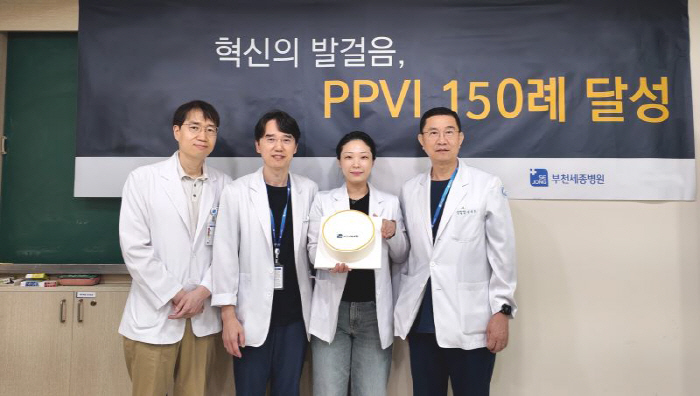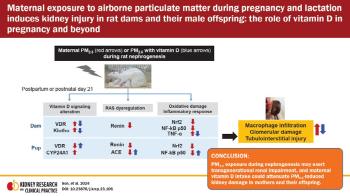More than 150 cases of percutaneous pulmonary arterial plate insertion (PPVI) at Bucheon Sejong Hospital
Nov 05, 2025
Bucheon Sejong Hospital (Hospital Director Lee Myung-mook) has exceeded 150 successful cases of 'percutaneous pulmonary arterial plate insertion'.
Percutaneous Pulmonic Valve Implantation (PPVI) is a high-level heart procedure performed only in some tertiary hospitals.
Bucheon Sejong Hospital has achieved excellent results in such high-level procedures, faithfully playing its role as the only heart hospital in Korea, while further enhancing its status as a secondary medical institution.
Bucheon Sejong Hospital said it has recently achieved this achievement since the first PPVI was performed on patients with Palosa signs with severe pulmonary arterial reflux in 2017.
PPVI is a high-level procedure in which a catheter is inserted through peripheral veins such as the femoral vein without incision in the chest to access the heart, and then a stent-integrated artificial pulmonary valve is inserted and deployed percutaneously in the area of the right ventricular outflow (native RVOT), the right ventricular-pulmonary artery (RV-PA conduit), or the previously inserted living body (tissue) pulmonary valve.
PPVI is performed for patients who have undergone corrective surgery or pulmonary valve intervention, including reconstruction due to right ventricular outflow, with stenosis due to right ventricular outflow or pulmonary valve failure of severity or severity.
Usually, such patients undergo a thoracic pulmonary valve replacement, in which the chest is incised to operate a cardiopulmonary device and then the valve is replaced.
However, there are limitations such as pain due to sternoclasts, extended hospitalization and recovery periods, and increased risk of adhesion and bleeding following repeated surgery.
PPVI is evaluated to complement these surgical limitations, and above all, to slow the timing of reoperation and to reduce the number of reoperation.
Bucheon Sejong Hospital has established a complete multidisciplinary cooperation system and a dedicated intervention team for the successful implementation of PPVI.
The intervention team consisted of all pediatric cardiologists Kim Sung-ho, Chang Ji-ik, Jeon Ji-seok, and Kim Jung-yoon.
In particular, Bucheon Sejong Hospital standardized the entire process for PPVI.
First, a precise anatomical evaluation is conducted using magnetic resonance imaging (MRI), computed tomography (CT), and ultrasound under close cooperation with the pediatric cardiac echocardiography team and the radiology department before the procedure.
Subsequently, the appropriateness of the indications will be reaffirmed through a conference with pediatric cardiology, pediatric thoracic surgery, and thoracic surgery. If necessary, further procedural strategies are determined in advance.
Through precise image-based patient selection, indication setting, and multidisciplinary evaluation and meeting before the procedure, a thorough plan and safety verification system were established.
Lee Myung-mook, director of Bucheon Sejong Hospital, said "Solid system construction, standardization, and high proficiency are key factors that improve the quality of the procedure and dramatically lower the risk of complications" and "On this basis, we were able to achieve very good results in the PPVI field."
Based on the clinical experience and evidence accumulated so far, we will continue to expand education and research to prove the results with 'Safety' and 'Results'," he added.
Percutaneous Pulmonic Valve Implantation (PPVI) is a high-level heart procedure performed only in some tertiary hospitals.
Bucheon Sejong Hospital has achieved excellent results in such high-level procedures, faithfully playing its role as the only heart hospital in Korea, while further enhancing its status as a secondary medical institution.
Bucheon Sejong Hospital said it has recently achieved this achievement since the first PPVI was performed on patients with Palosa signs with severe pulmonary arterial reflux in 2017.
PPVI is a high-level procedure in which a catheter is inserted through peripheral veins such as the femoral vein without incision in the chest to access the heart, and then a stent-integrated artificial pulmonary valve is inserted and deployed percutaneously in the area of the right ventricular outflow (native RVOT), the right ventricular-pulmonary artery (RV-PA conduit), or the previously inserted living body (tissue) pulmonary valve.
PPVI is performed for patients who have undergone corrective surgery or pulmonary valve intervention, including reconstruction due to right ventricular outflow, with stenosis due to right ventricular outflow or pulmonary valve failure of severity or severity.
Usually, such patients undergo a thoracic pulmonary valve replacement, in which the chest is incised to operate a cardiopulmonary device and then the valve is replaced.
However, there are limitations such as pain due to sternoclasts, extended hospitalization and recovery periods, and increased risk of adhesion and bleeding following repeated surgery.
PPVI is evaluated to complement these surgical limitations, and above all, to slow the timing of reoperation and to reduce the number of reoperation.
Bucheon Sejong Hospital has established a complete multidisciplinary cooperation system and a dedicated intervention team for the successful implementation of PPVI.
The intervention team consisted of all pediatric cardiologists Kim Sung-ho, Chang Ji-ik, Jeon Ji-seok, and Kim Jung-yoon.
In particular, Bucheon Sejong Hospital standardized the entire process for PPVI.
First, a precise anatomical evaluation is conducted using magnetic resonance imaging (MRI), computed tomography (CT), and ultrasound under close cooperation with the pediatric cardiac echocardiography team and the radiology department before the procedure.
Subsequently, the appropriateness of the indications will be reaffirmed through a conference with pediatric cardiology, pediatric thoracic surgery, and thoracic surgery. If necessary, further procedural strategies are determined in advance.
Through precise image-based patient selection, indication setting, and multidisciplinary evaluation and meeting before the procedure, a thorough plan and safety verification system were established.
Lee Myung-mook, director of Bucheon Sejong Hospital, said "Solid system construction, standardization, and high proficiency are key factors that improve the quality of the procedure and dramatically lower the risk of complications" and "On this basis, we were able to achieve very good results in the PPVI field."
Based on the clinical experience and evidence accumulated so far, we will continue to expand education and research to prove the results with 'Safety' and 'Results'," he added.
|
This article was translated by Naver AI translator.














